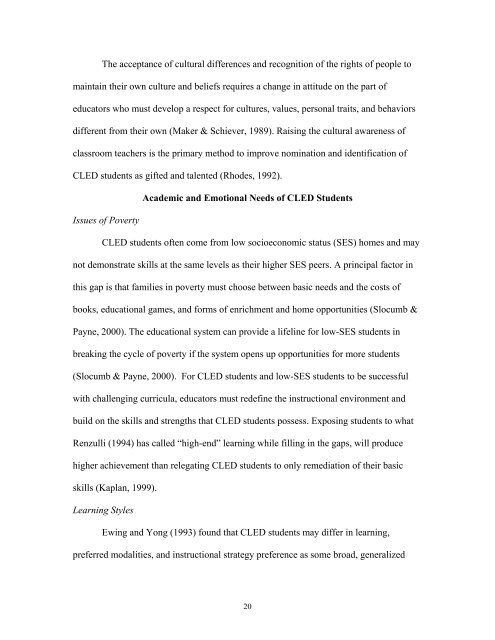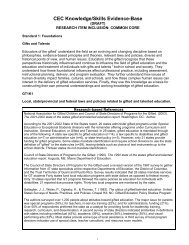Chapter One An Introduction to the Topic of Cultural Diversity - NAGC
Chapter One An Introduction to the Topic of Cultural Diversity - NAGC
Chapter One An Introduction to the Topic of Cultural Diversity - NAGC
You also want an ePaper? Increase the reach of your titles
YUMPU automatically turns print PDFs into web optimized ePapers that Google loves.
The acceptance <strong>of</strong> cultural differences and recognition <strong>of</strong> <strong>the</strong> rights <strong>of</strong> people <strong>to</strong><br />
maintain <strong>the</strong>ir own culture and beliefs requires a change in attitude on <strong>the</strong> part <strong>of</strong><br />
educa<strong>to</strong>rs who must develop a respect for cultures, values, personal traits, and behaviors<br />
different from <strong>the</strong>ir own (Maker & Schiever, 1989). Raising <strong>the</strong> cultural awareness <strong>of</strong><br />
classroom teachers is <strong>the</strong> primary method <strong>to</strong> improve nomination and identification <strong>of</strong><br />
CLED students as gifted and talented (Rhodes, 1992).<br />
Academic and Emotional Needs <strong>of</strong> CLED Students<br />
Issues <strong>of</strong> Poverty<br />
CLED students <strong>of</strong>ten come from low socioeconomic status (SES) homes and may<br />
not demonstrate skills at <strong>the</strong> same levels as <strong>the</strong>ir higher SES peers. A principal fac<strong>to</strong>r in<br />
this gap is that families in poverty must choose between basic needs and <strong>the</strong> costs <strong>of</strong><br />
books, educational games, and forms <strong>of</strong> enrichment and home opportunities (Slocumb &<br />
Payne, 2000). The educational system can provide a lifeline for low-SES students in<br />
breaking <strong>the</strong> cycle <strong>of</strong> poverty if <strong>the</strong> system opens up opportunities for more students<br />
(Slocumb & Payne, 2000). For CLED students and low-SES students <strong>to</strong> be successful<br />
with challenging curricula, educa<strong>to</strong>rs must redefine <strong>the</strong> instructional environment and<br />
build on <strong>the</strong> skills and strengths that CLED students possess. Exposing students <strong>to</strong> what<br />
Renzulli (1994) has called “high-end” learning while filling in <strong>the</strong> gaps, will produce<br />
higher achievement than relegating CLED students <strong>to</strong> only remediation <strong>of</strong> <strong>the</strong>ir basic<br />
skills (Kaplan, 1999).<br />
Learning Styles<br />
Ewing and Yong (1993) found that CLED students may differ in learning,<br />
preferred modalities, and instructional strategy preference as some broad, generalized<br />
20

















